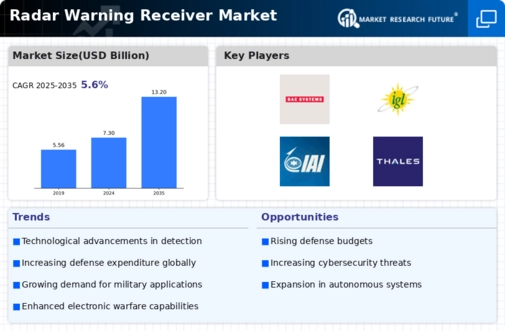Top Industry Leaders in the Radar Warning Receiver Market

The Radar Warning Receiver (RWR) market is a vital segment within the defense industry, providing electronic warfare capabilities that enable military aircraft to detect and respond to radar threats. Key players in this market consist of established defense electronics manufacturers, avionics specialists, and companies focusing on electronic warfare systems, all contributing to the development and enhancement of RWR technologies.
Key Players:
- ASELSAN A.Ş.(Turkey)
- BAE Systems (UK)
- Bharat Electronics Limited (India)
- Indra (Spain)
- Israel Aerospace Industries Ltd. (Israel)
- Leonardo S.p.A (Italy)
- Lockheed Martin Corporation (US)
- Raytheon Company (US)
- Saab AB (Sweden)
- Thales Group (France)
Strategies Adopted: Strategies adopted by key players in the Radar Warning Receiver market revolve around continuous technological innovation, international collaborations, and diversification of electronic warfare portfolios. Significant investments in research and development are essential to stay ahead of evolving radar threat technologies and to enhance the detection capabilities of RWR systems. Collaborations with defense agencies, international partners, and aircraft manufacturers are common, facilitating the integration of RWRs into various military platforms. Moreover, strategic diversification into complementary electronic warfare solutions, such as countermeasure systems, contributes to the market presence of leading companies.
Factors for Market Share Analysis: Market share analysis in the Radar Warning Receiver sector considers various factors, including the sensitivity and frequency coverage of RWR systems, adaptability to different aircraft platforms, integration capabilities with other electronic warfare systems, and the ability to counteract sophisticated radar threats. The capability to offer comprehensive threat identification and prioritization, along with quick response times, plays a significant role in determining market share. Additionally, factors such as reliability, ease of maintenance, and compliance with military standards contribute to the overall competitiveness of Radar Warning Receiver providers.
New and Emerging Companies: The Radar Warning Receiver market is witnessing the emergence of new and innovative companies focusing on niche areas such as cognitive electronic warfare, machine learning for threat identification, and miniaturization of RWR technologies. Start-ups like Robin Radar Systems and Plath GmbH are contributing to advancements in radar threat detection and electronic warfare solutions. These companies often emphasize agility, adaptability, and the incorporation of cutting-edge technologies, challenging traditional players and contributing to the evolution of RWR technologies.
Industry News: Industry news in the Radar Warning Receiver market frequently highlights successful test evaluations, advancements in signal processing capabilities, and collaborations between RWR providers and military organizations. Recent developments, such as the integration of machine learning algorithms for threat discrimination, the successful deployment of RWR systems on next-generation fighter aircraft, and partnerships for joint development programs, showcase the industry's commitment to innovation and addressing the evolving needs of electronic warfare. News related to successful field trials, certification processes, and the adoption of emerging technologies further shape industry perceptions and influence competitive dynamics.
Current Company Investment Trends: Investments in signal processing, machine learning, and spectrum awareness technologies remain key trends in the Radar Warning Receiver market. Key players allocate substantial resources to research and development activities aimed at enhancing RWR capabilities, improving threat identification accuracy, and addressing emerging radar threat scenarios. Investments also focus on the development of modular and scalable RWR solutions to ensure compatibility with a wide range of aircraft platforms. Strategic acquisitions and partnerships contribute to expanding electronic warfare portfolios, addressing emerging market needs, and strengthening the overall competitiveness of Radar Warning Receiver providers.
Overall Competitive Scenario: The overall competitive scenario in the Radar Warning Receiver market is marked by a balance between established defense electronics manufacturers and innovative newcomers. Established players leverage their experience, global reach, and diversified electronic warfare portfolios to maintain a competitive edge. Simultaneously, emerging companies contribute to the market's dynamism by introducing novel technologies and addressing specific challenges associated with radar threat detection. The trend towards cognitive electronic warfare, advanced threat libraries, and the integration of RWRs into broader electronic warfare suites further intensifies competition in this market.
Recent Development:
Lockheed Martin:
Secured a multi-million-dollar contract to supply its AN/ALR-69A(V)5 RWR suite for F-16 fighter jets of several countries. This highlights the continued demand for proven and reliable RWR systems for military aircraft.
Developing the next-generation AN/ALR-94 RWR system with enhanced threat detection and analysis capabilities, incorporating advanced signal processing and AI algorithms. This innovation focuses on staying ahead of evolving radar threats.
BAE Systems:
Won a contract to provide its ASQ-238 RWR system for the Eurofighter Typhoon multirole fighter jet. This reinforces BAE Systems' position as a major supplier of RWR technology for combat aircraft.
Partnering with research institutions to explore the integration of GaN-based radar technology into RWR systems, offering improved sensitivity and detection range. This collaboration reflects the focus on cutting-edge materials and technologies.











